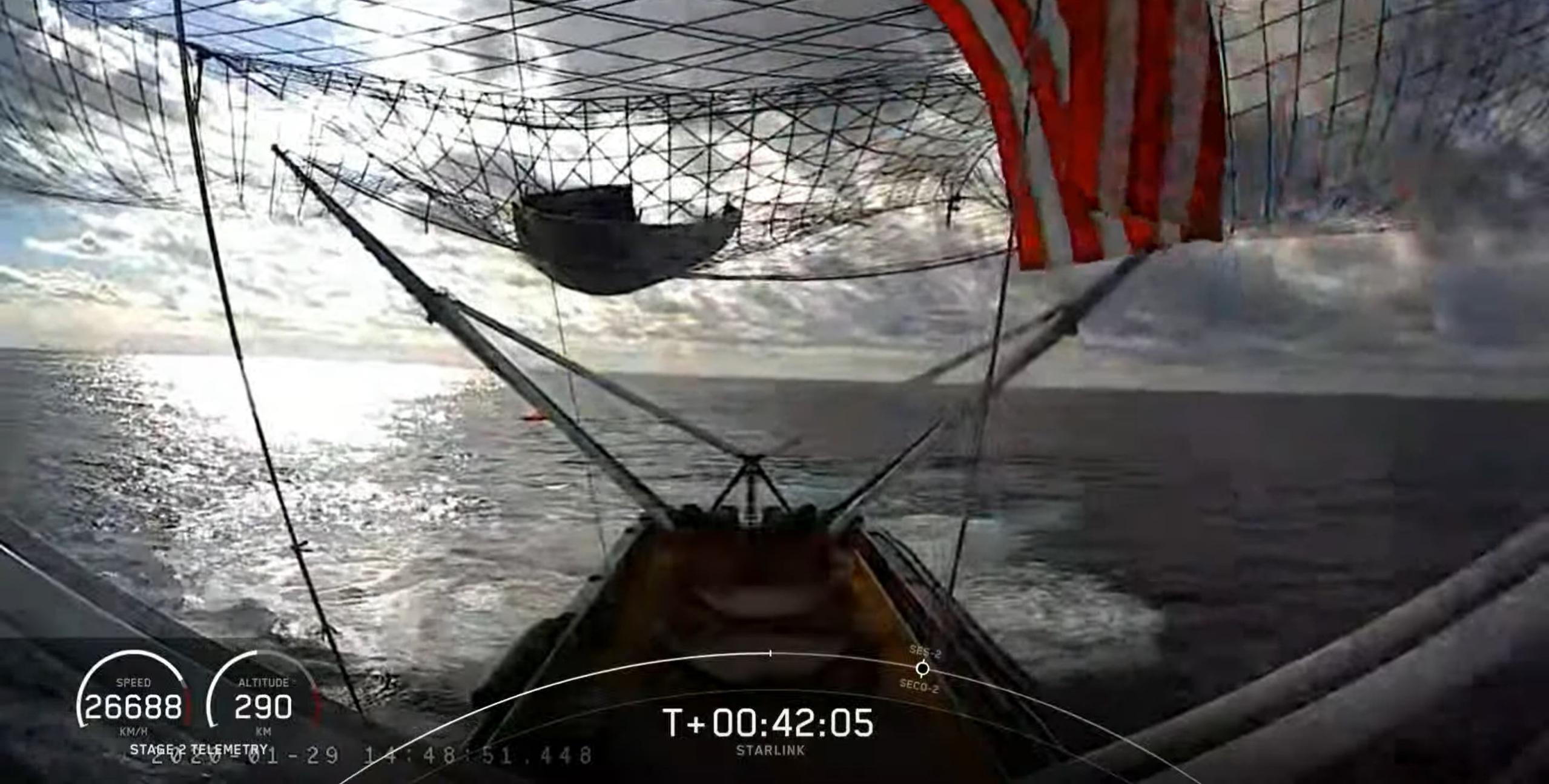
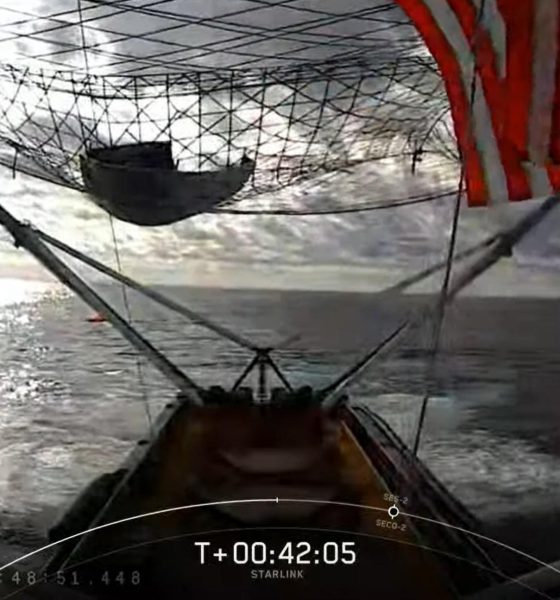
News
SpaceX just caught its first rocket nosecone in 5 months (and the booster landed, too)
One of SpaceX’s net-outfitted recovery ships has just completed the company’s first successful Falcon 9 nosecone (payload fairing) catch in more than five months, although the ship’s twin was not so lucky.
Known as GO Ms. Tree (formerly Mr. Steven) and GO Ms. Chief, today’s recovery attempt marked the second time ever that both ships simultaneously attempted to catch both halves of a Falcon 9 payload fairing. Outfitted with giant nets, those ships are meant to keep those featherweight fairings – flying with the help of GPS-guided parafoils – out of corrosive saltwater by being in exactly the right place at exactly the right time some 700-1000+ km (430-620+ mi) downrange. Unsurprisingly, consistently catching Falcon fairings has proven to be incredibly challenging — perhaps even more so than recovering Falcon 9 boosters.
As evidence, on today’s attempt – despite both ships being present in almost identical conditions, only one ship – Ms. Tree – managed to catch its assigned fairing half, while Ms. Chief missed her shot. For fairing recovery in general, this is SpaceX’s first successful catch in more than five months and third successful catch ever since attempts first began in early 2018.
Given the mechanics of the feat, it’s not all that surprising that Falcon fairing recovery has proven so exceptionally challenging. First and foremost, Falcon payload fairings are only worth around $6 million total – less than 10% of Falcon 9’s current base price and even less for Falcon Heavy, advertised with a base price of $90M per launch. If, for example, SpaceX ends up spending $100-200 million developing fairing recovery, it will take a bare minimum of 15-30+ flawless recoveries (of both halves, no less) to recoup the company’s investment.
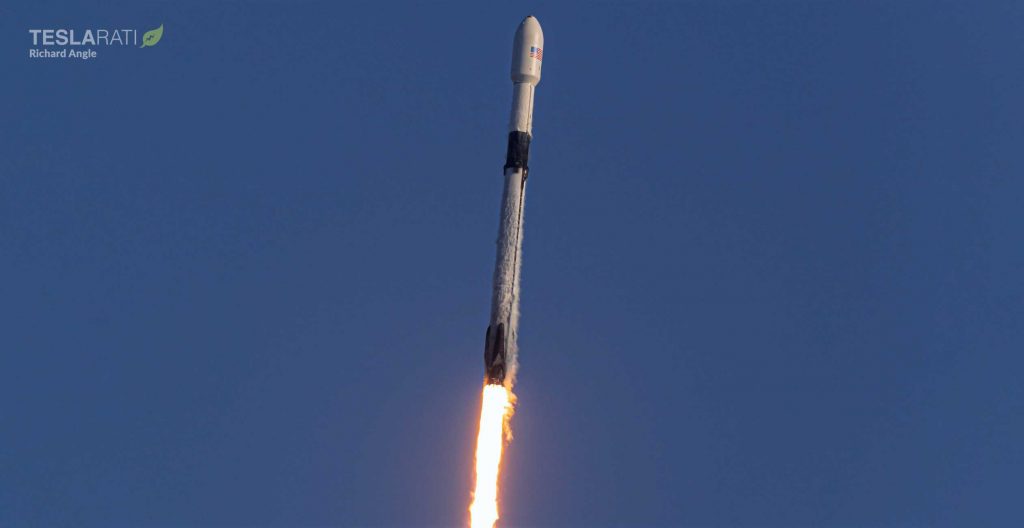
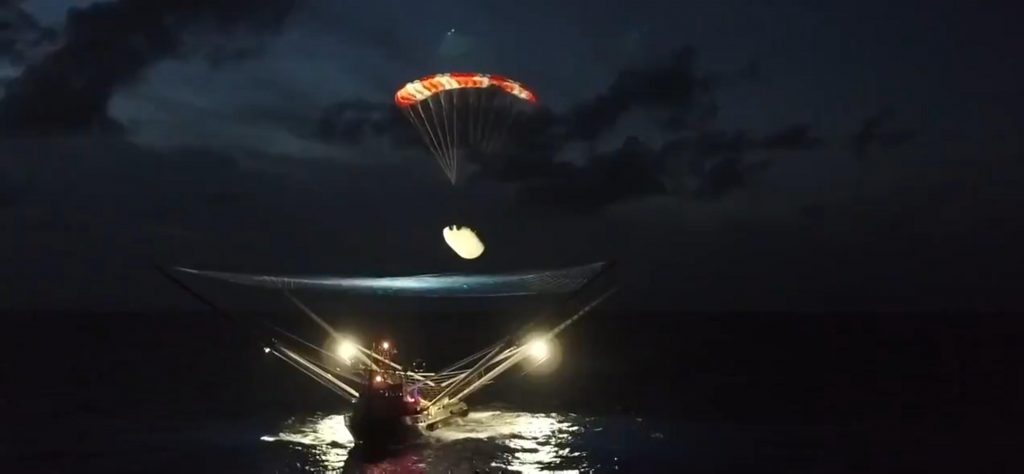
Still, given that SpaceX will need no fewer than 75-190+ dedicated Falcon 9 launches to orbit its entire licensed Starlink constellation, it’s not surprising that the company has deemed the investment and major challenges worth it. While the payload fairing only represents 10% of the cost of a new Falcon 9, accounting for the booster reuse that is more or less guaranteed on all Starlink missions means that the fairing could actually represent more like 30%+ of the cost to SpaceX for each internal Starlink launch.
Ultimately, even on the low end of Starlink’s required Falcon 9 launches, recovering and reusing payload fairings could save SpaceX hundreds of millions of dollars. Not only that, reliable fairing recovery would mean that SpaceX can close the recovery loop on both Falcon 9 boosters and fairings, representing some 75-80% of the rocket’s total cost. In other words, recovering fairings could allow SpaceX to lower the cost of launch to something like $15 or $20M for each Starlink mission — simply inconceivable and definitely unbeatable for more than 15 metric tons (33,000 lb) to low Earth orbit (LEO).
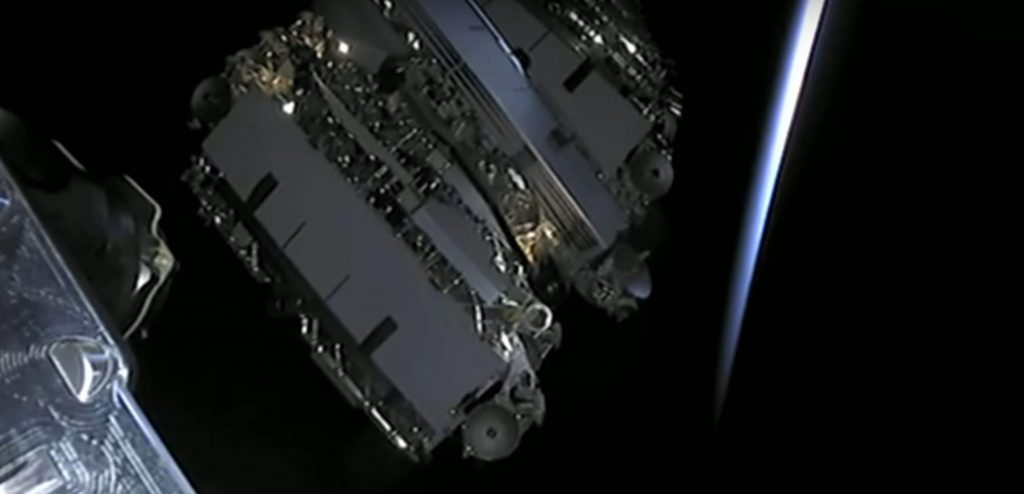
Meanwhile, some 35 minutes before Ms. Tree caught her third Falcon fairing, Falcon 9 booster B1051 nailed its third drone ship landing in 10 months, setting the rocket up for a fourth launch and landing sometime in the near future.
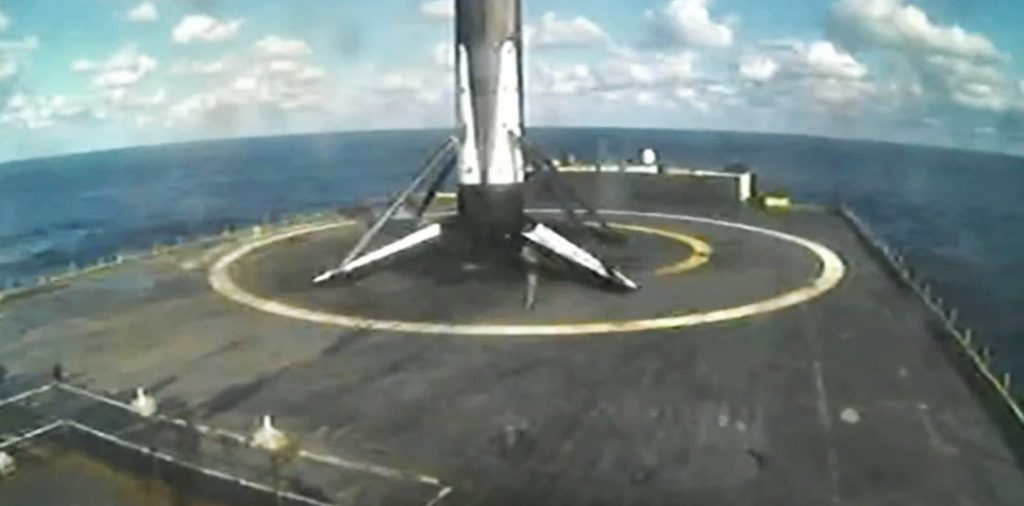
A little over an hour after liftoff, Falcon 9’s second stage spun itself up like a propeller and released the fourth batch of 60 Starlink satellites, completing the company’s third flawless launch of 2020 and taking SpaceX a step towards providing Starlink internet to customers around the world.
Check out Teslarati’s Marketplace! We offer Tesla accessories, including for the Tesla Cybertruck and Tesla Model 3.

News
Tesla hosts Rome Mayor for first Italian FSD Supervised road demo
The event marked the first time an Italian mayor tested the advanced driver-assistance system in person in Rome’s urban streets.
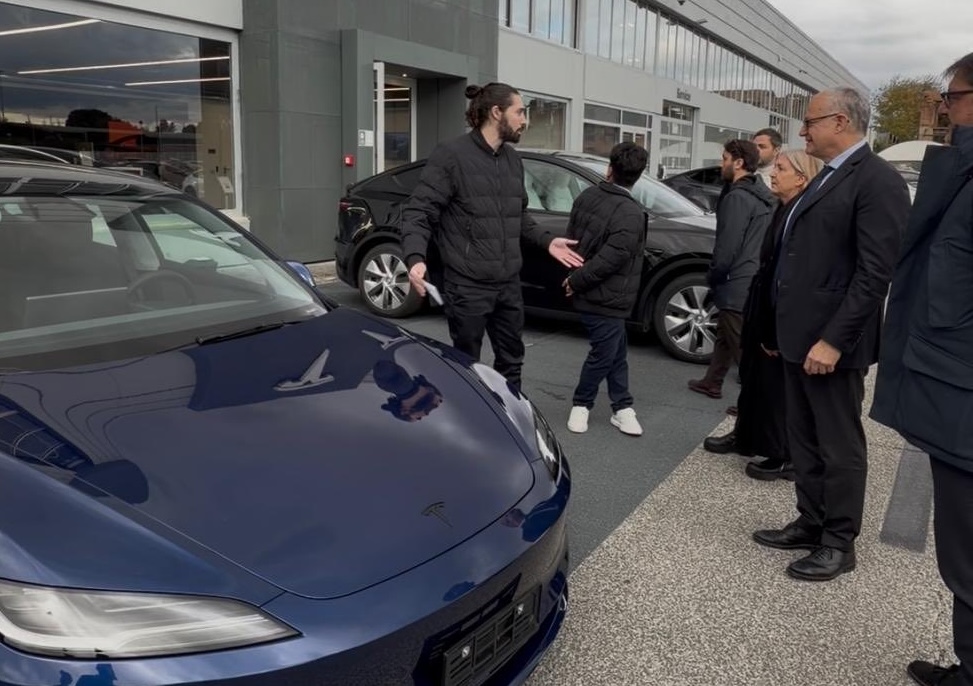
Tesla definitely seems to be actively engaging European officials on FSD’s capabilities, with the company hosting Rome Mayor Roberto Gualtieri and Mobility Assessor Eugenio Patanè for a hands-on road demonstration.
The event marked the first time an Italian mayor tested the advanced driver-assistance system in person in Rome’s urban streets. This comes amid Tesla’s push for FSD’s EU regulatory approvals in the coming year.
Rome officials experience FSD Supervised
Tesla conducted the demo using a Model 3 equipped with Full Self-Driving (Supervised), tackling typical Roman traffic including complex intersections, roundabouts, pedestrian crossings and mixed users like cars, bikes and scooters.
The system showcased AI-based assisted driving, prioritizing safety while maintaining flow. FSD also handled overtakes and lane decisions, though with constant driver supervision.
Investor Andrea Stroppa detailed the event on X, noting the system’s potential to reduce severe collision risks by up to seven times compared to traditional driving, based on Tesla’s data from billions of global fleet miles. The session highlighted FSD’s role as an assistance tool in its Supervised form, not a replacement, with the driver fully responsible at all times.
Path to European rollout
Tesla has logged over 1 million kilometers of testing across 17 European countries, including Italy, to refine FSD for local conditions. The fact that Rome officials personally tested FSD Supervised bodes well for the program’s approval, as it suggests that key individuals are closely watching Tesla’s efforts and innovations.
Assessor Patanè also highlighted the administration’s interest in technologies that boost road safety and urban travel quality, viewing them as aids for both private and public transport while respecting rules.
Replies on X urged involving Italy’s Transport Ministry to speed approvals, with one user noting, “Great idea to involve the mayor! It would be necessary to involve components of the Ministry of Transport and the government as soon as possible: it’s they who can accelerate the approval of FSD in Italy.”
News
Tesla FSD (Supervised) blows away French journalist after test ride
Cadot described FSD as “mind-blowing,” both for the safety of the vehicle’s driving and the “humanity” of its driving behaviors.
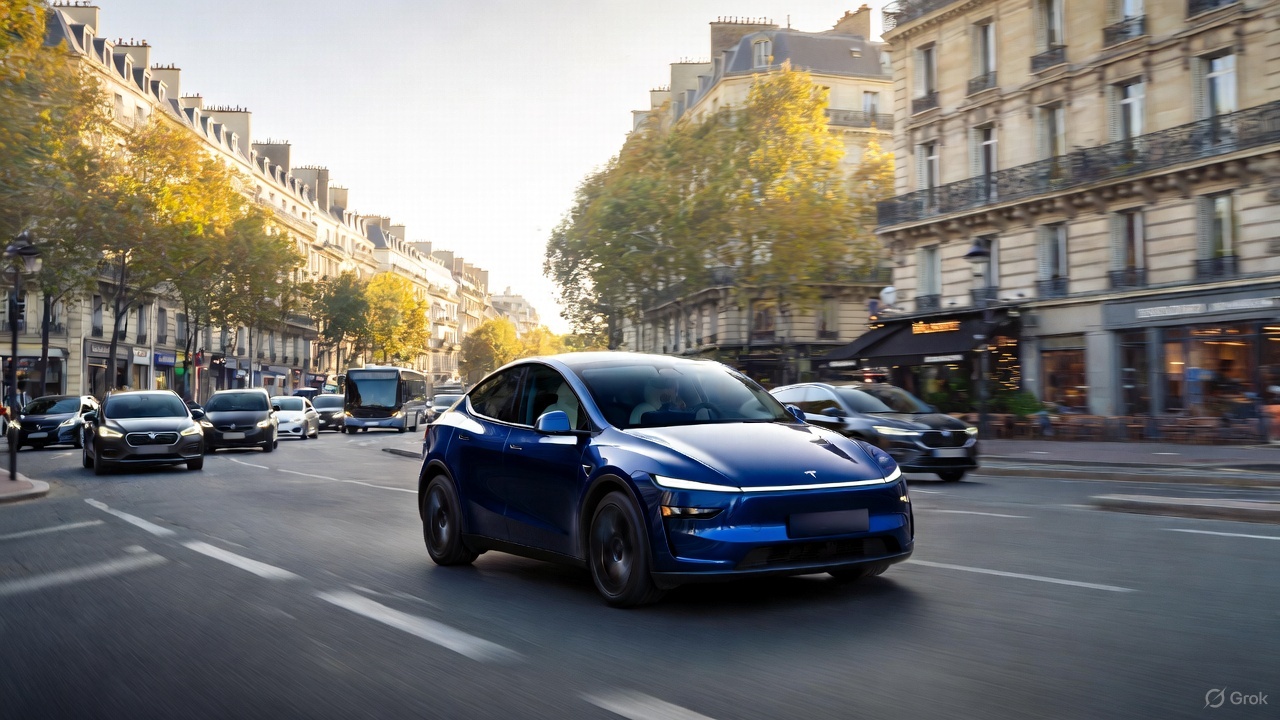
Tesla’s Full Self-Driving (Supervised) seems to be making waves in Europe, with French tech journalist Julien Cadot recently sharing a positive first-hand experience from a supervised test drive in France.
Cadot, who tested the system for Numerama after eight years of anticipation since early Autopilot trials, described FSD as “mind-blowing,” both for the safety of the vehicle’s driving and the “humanity” of its driving behaviors.
Julien Cadot’s FSD test in France
Cadot announced his upcoming test on X, writing in French: “I’m going to test Tesla’s FSD for Numerama in France. 8 years I’ve been waiting to relive the sensations of our very first contact with the unbridled Autopilot of the 2016s.” He followed up shortly after with an initial reaction, writing: “I don’t want to spoil too much because as media we were allowed to film everything and I have a huge video coming… But: it’s mind-blowing! Both for safety and for the ‘humanity’ of the choices.”
His later posts detailed FSD’s specific maneuvers that he found particularly compelling. These include the vehicle safely overtaking a delivery truck by inches, something Cadot said he personally would avoid to protect his rims, but FSD handled flawlessly. He also praised FSD’s cyclist overtakes, as the system always maintained the required 1.5-meter distance by encroaching on the opposite lane when clear. Ultimately, Cadot noted FSD’s decision-making prioritized safety and advancement, which is pretty remarkable.
FSD’s ‘human’ edge over Autopilot
When asked if FSD felt light-years ahead of standard Autopilot, Cadot replied: “It’s incomparable, it’s not the same language.” He elaborated on scenarios like bypassing a parked delivery truck across a solid white line, where FSD assessed safety and proceeded just as a human driver might, rather than halting indefinitely. This “humanity” impressed Cadot the most, as it allowed FSD to fluidly navigate real-world chaos like urban Paris traffic.
Tesla is currently hard at work pushing for the rollout of FSD to several European countries. Recent reports have revealed that Tesla has received approval to operate 19 FSD test vehicles on Spain’s roads, though this number could increase as the program develops. As per the Dirección General de Tráfico (DGT), Tesla would be able to operate its FSD fleet on any national route across Spain. Recent job openings also hint at Tesla starting FSD tests in Austria. Apart from this, the company is also holding FSD demonstrations in Germany, France, and Italy.
Elon Musk
Tesla Optimus shows off its newest capability as progress accelerates

Tesla Optimus showed off its newest capability as progress on the project continues to accelerate toward an ultimate goal of mass production in the coming years.
Tesla is still developing Optimus and preparing for the first stages of mass production, where units would be sold and shipped to customers. CEO Elon Musk has always marketed the humanoid robot as the biggest product in history, even outside of Tesla, but of all time.
He believes it will eliminate the need to manually perform monotonous tasks, like cleaning, mowing the lawn, and folding laundry.
However, lately, Musk has revealed even bigger plans for Optimus, including the ability to relieve humans of work entirely within the next 20 years.
JUST IN: Elon Musk says working will be ‘optional’ in less than 20 years because of AI and robotics. pic.twitter.com/l3S5kl5HBB
— Watcher.Guru (@WatcherGuru) November 30, 2025
Development at Tesla’s Artificial Intelligence and Robotics teams has progressed, and a new video was shown of the robot taking a light jog with what appeared to be some pretty natural form:
Just set a new PR in the lab pic.twitter.com/8kJ2om7uV7
— Tesla Optimus (@Tesla_Optimus) December 2, 2025
Optimus has also made several public appearances lately, including one at the Neural Information Processing Systems, or NeurIPS Conference. Some spectators shared videos of Optimus’s charging rig, as well as its movements and capabilities, most interestingly, the hand:
You have to hand it to Elon 🤟 pic.twitter.com/fZKDlmGAbe
— Ric Burton · NeurIPS 2025 (@_ricburton) December 2, 2025
The hand, forearm, and fingers have been one of the most evident challenges for Tesla in recent times, especially as it continues to work on its 3rd Generation iteration of Optimus.
Musk said during the Q3 Earnings Call:
“I don’t want to downplay the difficulty, but it’s an incredibly difficult thing, especially to create a hand that is as dexterous and capable as the human hand, which is incredible. The human hand is an incredible thing. The more you study the human hand, the more incredible you realize it is, and why you need four fingers and a thumb, why the fingers have certain degrees of freedom, why the various muscles are of different strengths, and fingers are of different lengths. It turns out that those are all there for a reason.”
The interesting part of the Optimus program so far is the fact that Tesla has made a lot of progress with other portions of the project, like movement, for example, which appears to have come a long way.
However, without a functional hand and fingers, Optimus could be rendered relatively useless, so it is evident that it has to figure this crucial part out first.








